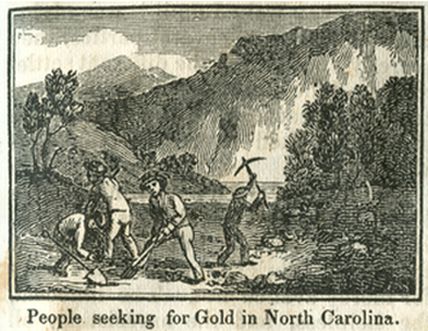See also: Gold Hill Mine; Portis Gold Mine; Reed Gold Mine; Gold Rush, The North Carolina; Gold Mining in the Uwharries

The precious metal gold is found as grains and nuggets in stream bed deposits, in veins, and as mineralized zones in schists and slates of the middle and western counties of North Carolina. The first authenticated discovery of gold was in 1799 at the farm of John Reed in Cabarrus County; Reed Gold Mine, established in 1803, was said to have yielded $1 million worth of gold between 1804 and 1846 and later became a State Historic Site.
Reed's initial strike and other early finds were celebrated in print across the country and even in Europe, prompting a rush of placer miners eager to sift through North Carolina's stream beds for surface deposits of gold. Many farmers sold their mineral rights and sometimes their entire farms to speculators and entrepreneurs who were hoping to unearth large quantities of gold. In 1824 the first lode deposit was worked on Tobias Barringer's land in Stanly County. Many mines followed in its wake, including Union County's Smart Mine (operational from 1835 to 1911) and Howie Mine (1840 to 1942). In the 1830s and 1840s, the peak years of the North Carolina gold rush, the state was home to about 56 different mining operations, and boom towns were established to support the thriving industry and its 25,000-strong workforce.
North Carolina's gold belt counties-which also included Davidson, Guilford, McDowell, and Randolph-produced the nation's gold supply from 1803 to 1848, when California emerged as the industry leader. Until 1829, North Carolina was also the only state producing domestic gold for the nation's coinage, prompting the U.S. government to open a branch mint in Charlotte in 1835. Mining continued at intervals up to 1971, yielding a total output estimated at $25 million (the vast majority found before 1900). Traces of gold were discovered during excavations for the One First Union Center in downtown Charlotte in 1988 and beneath the NationsBank (Bank of America) Corporate Center in 1992.